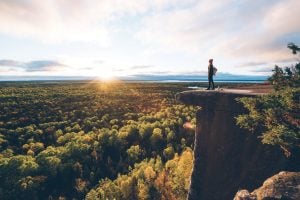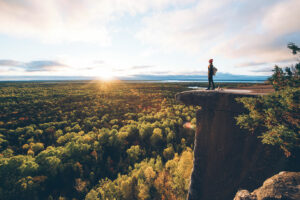
Travel
How to stop a gold rush
The new movement building flourishing tourism hubs across Canada – one sustainable example at a time
- 3297 words
- 14 minutes
Travel
In the wake of the sudden deadly eruption of New Zealand’s White Island volcano this week, explorer George Kourounis looks at why we’re drawn to active volcanoes — and how to explore them safely

Earlier this week shocking news reports started to come out of New Zealand about a sudden, unexpected eruption of White Island volcano. As I write this at least six people have died, eight more are missing, and 31 are still in hospital suffering from extensive burns to their bodies, and some to the insides of their lungs, the result of inhaling hot gases and ash from the eruption. Search and rescue teams are still looking for survivors, but officials have little hope of finding anyone alive on the island. The victims were tourists on a day trip to the volcano — something that is done every day, and has been going on for many years. The volcano is considered to be active, with the last eruption occurring in 2001. How could this deadly eruption have taken everyone seemingly by surprise?
In the weeks leading up to the eruption, the volcano alert level had been raised from level 1 to level 2, which is described as “moderate to heightened volcanic unrest.” Local tour operators are still allowed to bring people to the island during periods of level 2 activity.
Having witnessed countless volcanic eruptions myself, I scoured the cellphone videos taken by survivors as they fled the island by boat, looking for evidence of what might have happened. The sudden explosion was likely caused by an interaction between the shallow magma that lies below the island and some form of ground water. When the two forces come together, the super-heated water flashes to steam and violently expands. These phreatic eruptions can come with little or no warning and are among the most difficult to predict. The expanding steam pulverizes rock into ash and has the power to launch larger rocks great distances, sometimes at super-sonic speeds.
About 10,000 people visit White Island every year. The volcano is privately owned, and used to be the site of a sulphur mining operation until a volcanic mudflow called a lahar occurred in 1914, killing 10 workers. Attempts were made to re-invigorate the industry there, but all operations were eventually abandoned in the 1930s. Some of the mining equipment remained on the island and became part of the attraction for visitors to the volcano.
I remember my own visit to White Island in 2009. I was there filming for the Angry Planet TV series. To get there involves a nauseating boat ride into the Bay of Plenty, but it was a place that I had wanted to see for a long time, and even my seasickness couldn’t contain my excitement as we approached the island.
White Island is much larger than it looks. The visible portion is about 320 metres above sea level, but like an iceberg, the vast majority of it is hidden under the waves and rises up from the seafloor 1,600 metres below.
My personal experience there was one of wide-eyed wonderment. Every volcano has a different “personality” and White Island was no exception. As we walked around inside the crater we encountered a variety of volcanic activity: boiling pits of grey mud, fumaroles of sulphur dioxide gas that violently spewed out of cracks in the Earth, some so loud they sounded like jet engines. There was even a crater lake of steaming hot acidic water where, from time to time, tornado-like whirls called steam devils would form and dance across the surface of the acid like toxic ghosts.
Surreal sights like these are why each year, millions of visitors are drawn to explore active volcanoes such as Bromo in Indonesia, Etna and Vesuvius in Italy, and Kilauea in Hawaii, just to name a few. Volcanoes are the only places on Earth where we can witness first-hand the forces that created our planet. Peering down inside an active crater can be like looking into the centre of the Earth, especially if there is active lava present. It’s difficult to describe how mesmerizing it is to watch liquid rock boiling away, feeling the intense heat on your face and smelling brimstone, almost as if you’ve been transported back in time to our planet’s primordial beginnings. There’s value in educating our children about Earth sciences by showing them how these forces can create as well as destroy.
But is the reward worth the risk? Lives were lost in this eruption. These were people having a great time on their vacations, including a honeymooning couple. Statistically, the odds of anyone being injured or killed by a volcano that they’re visiting are extremely low. You’re more likely to be killed in traffic while vacationing in New York City or Paris. However, because of the unique dangers involved with visiting active volcanoes, one must weigh these risks when deciding whether to go or not.
Rightly, the New Zealand government has pledged to investigate the incident and determine if they should continue to allow visits to White Island. Regardless of what they decide, our fascination with these other-worldly places will not be going away any time soon, so it’s important to take precautions. Always heed official notices about volcanic activity, stay on marked trails, and whenever possible, travel with an experienced professional guide.
Are you passionate about Canadian geography?
You can support Canadian Geographic in 3 ways:

Travel
The new movement building flourishing tourism hubs across Canada – one sustainable example at a time

Travel
Jill Doucette, founder and CEO of Synergy Enterprises, shares insights on new trends in the tourism industry and why there’s reason to be optimistic about a sustainable future for travel

Exploration
Something melted a hole through the glacier above the Mount Meager Volcano in 2016. A perilous expedition ventured deep inside the cave to find out, did the volcano wake up?

Travel
Un nouveau mouvement créateur de pôles touristiques florissants dans tout le Canada – la durabilité, un exemple à la fois